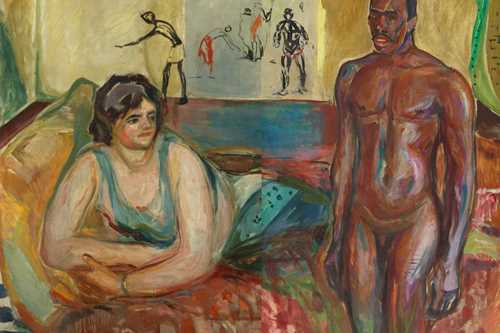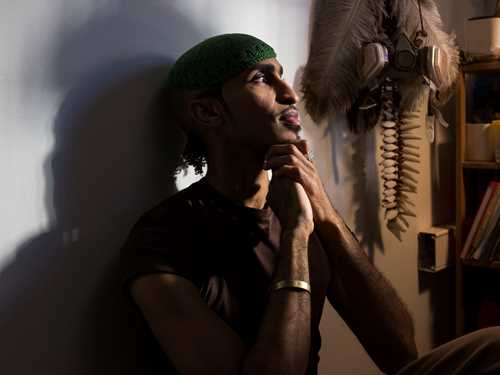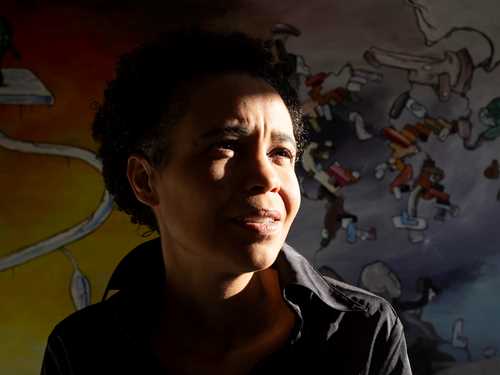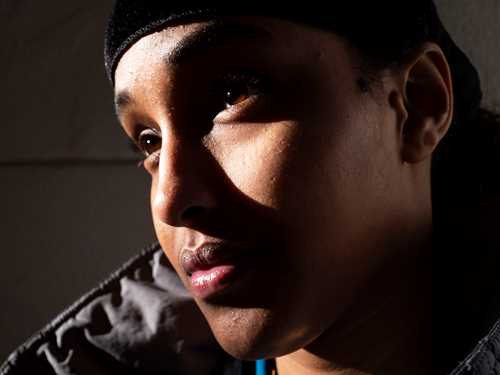Who was he really, the African man who modelled for Edvard Munch in 1916?
‘Sultan Abdul Karem’, it read on a small promotional card that Ludvig Ravensberg brought with him one autumn day in 1916. Together with his friend Edvard Munch, he had visited the German Hagenbeck Circus which was on tour in Oslo and noticed a ‘brave and attractive’ man, whom Ravensberg thought Munch should paint.
![Edvard Munch: [Title under consideration]. Oil on canvas, 1916. Photo © Munchmuseet](/globalassets/kunstverk/title.jpg?w=800)
Edvard Munch: [Title under consideration]. Oil on canvas, 1916. Photo © Munchmuseet
Edvard Munch regularly went to circuses and zoos to draw, and that was the purpose on this occasion as well. Ravensberg suggested that Munch should hire Karem as ‘servant, driver and model’, and the very next day he noted in his diary that Karem had come to visit Munch at Ekely.
![Edvard Munch: [Title under consideration]. Oil on canvas, 1916–1917. Photo © Munchmuseet](/globalassets/kunstverk/m0093_20151105.jpg?w=800)
Edvard Munch: [Title under consideration]. Oil on canvas, 1916–1917. Photo © Munchmuseet
A fruitful encounter
We do not know exactly how long Sultan Abdul Karem stayed with Edvard Munch, nor do we know if this was his real name. Perhaps it was a stage name he used at the circus, where he was part of the travelling troupe. But the visits to Munch’s atelier yielded results – the artist made seven oil paintings and one lithograph of Sultan Abdul Karem. In several of the pictures, Munch staged Karem in various different roles, as he often did with his models. In the painting Cleopatra and the Slave, for example, we see Karem as a slave figure, a motif that draws on the stereotypical and even racist notions of Africans at the time. But Munch also painted three portraits of Karem where he moves beyond the concept of ‘the exotic other’. In these paintings, we see Karem in ordinary, everyday clothes – not unlike the outfit Munch wore in a self-portrait he made a couple of years earlier. Perhaps it is here that we get closest to the person Munch met in his studio.
![Left: Edvard Munch: Self-Portrait in Hat and Coat. Oil on canvas, ca. 1915. Right: Edvard Munch: A[Title under consideration]. Oil on canvas, 1916–1917. Photo © Munchmuseet](/contentassets/38fe920e8c174dd189f74eb4962802d2/edvard-munch-og-abdul-karem.jpg?w=800)
Left: Edvard Munch: Self-Portrait in Hat and Coat. Oil on canvas, ca. 1915. Right: Edvard Munch: A[Title under consideration]. Oil on canvas, 1916–1917. Photo © Munchmuseet
Ethnicity as entertainment
Sultan Abdul Karem was the only person with an African background Munch painted. We do not know exactly where he came from, but since Hagenbeck Circus was German, he may have been brought to Europe from one of the former German colonies, such as present-day Tanzania or Namibia or parts of Congo or Kenya. In the 1920s or 1930s, Munch’s good friend Rolf Stenersen bought one half of Cleopatra and the Slave, for which Karem was a model. He called the painting ‘Abyssinian’, which was a term describing people from present-day Ethiopia. Since the name is so specific, it is conceivable that Stenersen – and perhaps also Munch – knew where Sultan Abdul Karem came from.
Through a news story in Morgenbladet from 1916, we also know something about what role Karem played in the circus. Here we learn that the circus offered an act that staged a ‘Negro’ and a group of ‘Mameluk Arabs’ in an entertaining feature. The Mamelukes were the caliphs’ and the sultans’ bodyguards from the twelfth century onwards, and it seems probable that this particular ‘number’ was a staging of the sultan and his bodyguards. Circus director Carl Hagenbeck had specialized in such ethnic shows, where he played on the audience’s notions of the exotic and the primitive in people from other cultures. Hagenbeck was not alone in this – from the end of the nineteenth century until well into the twentieth, people were brought from Africa and Asia to the colonial powers, where they were assigned stereotypical roles and put on display – often on an equal footing with animals.
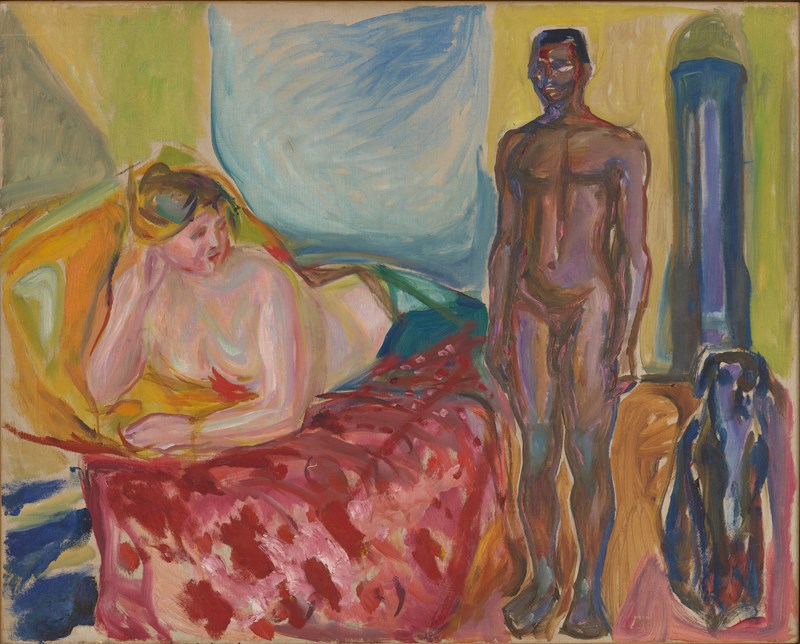
Edvard Munch: Cleopatra and the Slave. Oil on canvas, 1916-1920. Photo © Munchmuseet
The notion of ‘the other’
We do not know what happened to Sultan Abdul Karem after he visited Edvard Munch at Ekely. Most of the information we have about him comes from the pictures Munch painted and from Ludvig Ravensberg’s diary entries, which are not without racist undertones. In an entry from November 1916, Ravensberg compares the ‘Negro Sultan’ with Munch’s St Bernard dog Bamse and the two pigs Gunnar and Sivert. He comments that now Munch has his own little circus at Ekely. In the same way, the titles Edvard Munch gave the portraits of Karem would be considered problematic today. When Munch first exhibited a portrait of Karem at Blomqvist Gallery in Oslo in 1918, he gave the painting the title Araber grønt skjerf (meaning ‘Arab in a green scarf’). Three years later, he called it Neger med grønt skjerf (‘Negro with a green scarf’). Unlike most of the other people Munch portrayed, he did not use Karem’s name in the title. It may seem that to some extent he saw Karem as a representative of something different, perhaps exotic, rather than as an individual.
![Edvard Munch: [Title under consideration]. Oil on canvas, 1916. Photo © Munchmuseet](/globalassets/kunstverk/tittel-til-vurdreing.jpg?w=800)
Edvard Munch: [Title under consideration]. Oil on canvas, 1916. Photo © Munchmuseet
In the exhibition Call Me By My Name, the pictures Edvard Munch made of Sultan Abdul Karem are displayed together for the first time. In addition, we shed light on contemporary notions of Africans and people from other cultures through books, photographs and art objects. Another reason for the exhibition is that the titles of the paintings of Sultan Abdul Karem are once again being considered. They will now be revised and changed, as they have been before. There is still much we do not know about Sultan Abdul Karem and Munch’s encounter with him. But perhaps the images that emerged from their meeting can tell us something about our attitudes towards others – and about the way they are expressed today.
![Edvard Munch: [Title under consideration]. Oil on canvas, 1916. Photo © Munchmuseet](/globalassets/kunstverk/title.jpg?w=500&h=333&mode=Crop&quality=50&crop=0,56,2173,1504)
